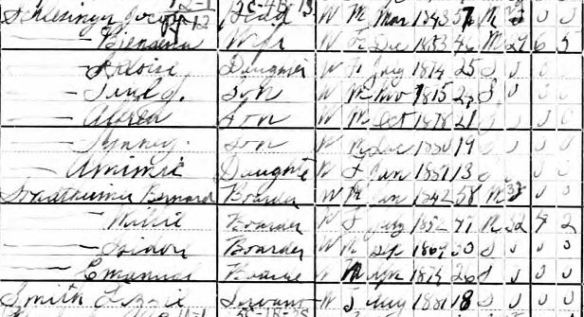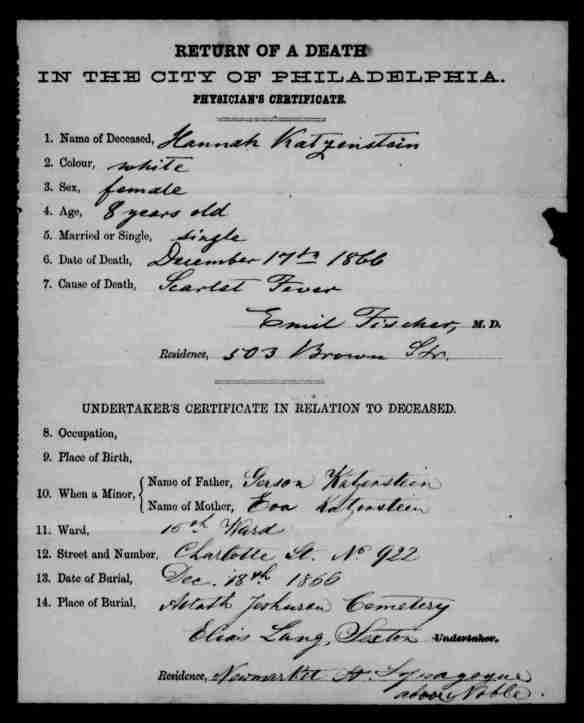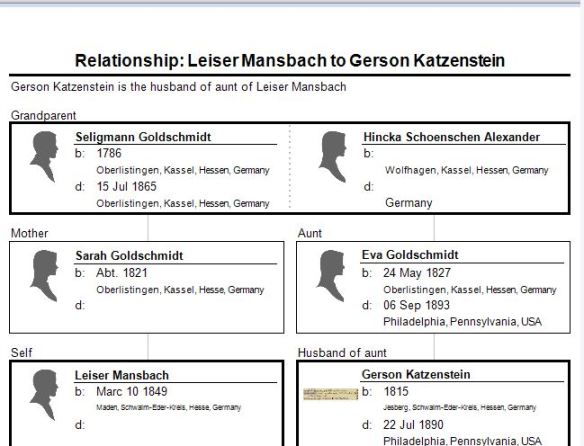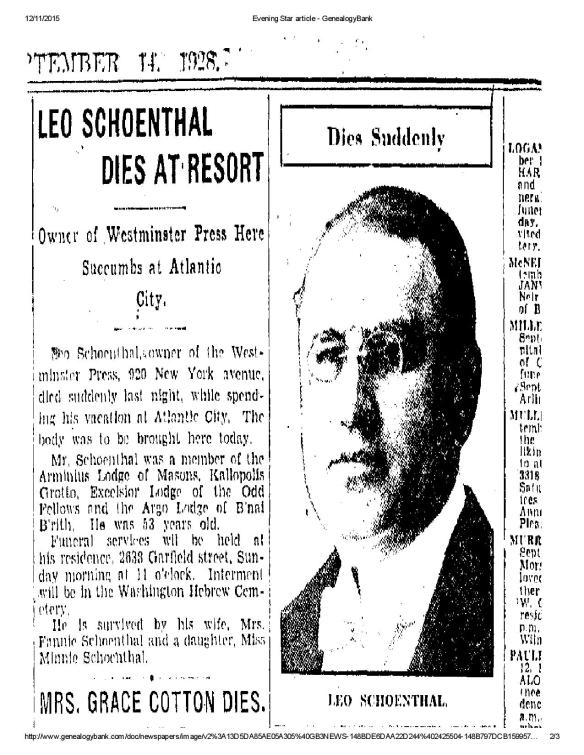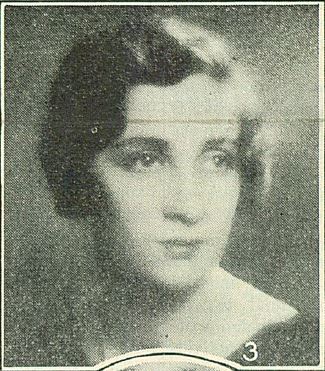In 1860, Simon Goldschmidt, now Simon Goldsmith, was a two-time widower living in Washington, Pennsylvania, with his oldest child from his first marriage, Jacob Goldsmith. Also living with them were Jacob’s wife Fannie Silverman and their six young daughters, Ellena, Emma, Annie, Rachel, Leonora, and Celia, and Simon’s two children, Henry and Hannah, from his second marriage to my three-times great-aunt Fradchen Schoenthal. Jacob was a merchant with $4500 worth of real estate and $6000 in personal property. In 1863, Jacob registered for the Civil War draft in Washington, Pennsylvania, but I have no record showing that he served in the war.1

Simon Goldsmith and family 1860 US census
Year: 1860; Census Place: Washington, Washington, Pennsylvania; Roll: M653_1192; Page: 1188; Image: 627; Family History Library Film: 805192
Jacob and Fannie had many more children in the 1860s; Felix (about 1860)2 and George (1862)3 were likely born in Washington, Pennsylvania, but by the time Frank4 was born in 1863, the family may already have moved to Philadelphia. The next five children were all born in Philadelphia: Edward (born as Oscar, 1864),5 Rebecca (1866),6 Florence (1869),7 and finally a set of twins born early in the next decade, Gertrude and Eva (born January 18, 1871).8 That brought the grand total of Jacob and Fannie’s children to fourteen—four sons and ten daughters. In 1870, Jacob and Fannie and their children were living in Philadelphia. Jacob was still a retail merchant and now had $20,000 in personal property.

Jacob Goldsmith and family, 1870 US census, Year: 1870; Census Place: Philadelphia Ward 12 Dist 36 (2nd Enum), Philadelphia, Pennsylvania; Roll: M593_1424; Page: 589B; Family History Library Film: 552923, Township: Philadelphia Ward 12 Dist 36 (2nd Enum),
Ancestry.com. 1870 United States Federal Census

Jacob Goldsmith and family, 1870 US census, Year: 1870; Census Place: Philadelphia Ward 12 District 36, Philadelphia, Pennsylvania. Ancestry.com
In 1860, Simon’s oldest daughter Lena was living about fifty miles away from her father in Connellsville, Pennsylvania, with her husband Gustavus Basch and their three young children, Frank, Jacob, and Hinda. Gustavus was a clothing merchant and had $3100 in personal property, according to the 1860 census.
Lena and Gustav Basch and family, 1860 census, Year: 1860; Census Place: Connellsville, Fayette, Pennsylvania; Roll: M653_1110; Page: 421; Family History Library Film: 805110 Source Information Ancestry.com. 1860 United States Federal Census
Like his brother-in-law Jacob, Gustavus registered for the Civil War draft in 1863, but I don’t know if he served.9 Lena and Gustavus’ family was also growing in the 1860s, but not as much as Jacob and Fannie’s. They added three more to their family in that decade: Joel (1863),10 Ella (1865),11 and Joseph (1867),12 all born in Connellsville. In 1868, Gustavus was listed as a clothier in Connellsville in the Pennsylvania State directory, but sometime thereafter he changed occupations and the family relocated.13 By 1870, the family had moved to Pittsburgh, and Gustavus was now working for H. Bier & Company, a brass founders and steam pump manufacturing company.14

Gustavus Basch 1870 US census, Year: 1870; Census Place: Pittsburgh Ward 2, Allegheny, Pennsylvania; Roll: M593_1295; Page: 423A; Family History Library Film: 552794
Ancestry.com. 1870 United States Federal Census,
As for Simon’s second oldest daughter Eva, as reported here in detail, I cannot find her in 1860, but I believe that sometime around 1860 she married Marcus Bohm, a Polish immigrant who had a store in Washington, Pennsylvania, until 1860. It also appears that Marcus and Eva had a daughter Ella, born in February, 1862. Also, as I wrote about earlier, it seems that Eva died sometime before 1870. Her daughter Ella Bohm was then living with her uncle Jacob Goldsmith and his family in Philadelphia. Ella’s father’s whereabouts are not known, although he appears to have been in New Jersey.
Meanwhile, Simon’s two youngest children, my double cousins Henry and Hannah Goldsmith, were teenagers in the 1860s. In 1867, Hannah married Joseph Benedict.15 She was only nineteen, and he was 33. Joseph was born July 3, 1834, in Germany and had immigrated in 1857, according to the 1900 census.16 I cannot find any immigration record for Joseph or a marriage record for Hannah and Joseph.
In 1865 a Joseph Benedict was working as a clerk in Pittsburgh.17 In 1868 he is listed in the Pittsburgh directory as a used furniture dealer, but in 1869 he is listed as a second-hand clothing dealer. The 1870 Pittsburgh directory lists him as a junk dealer, so maybe it was both clothing and furniture.18 The 1870 census merely lists his occupation as “retail.” By that time Joseph and Hannah had a five-month-old son named Jacob, born January 24, 1870, in Pittsburgh.19 Also living with them in 1870 were Hannah’s father, Simon Goldsmith, now a retired tailor, and Amelia Schoenthal, who was Hannah’s first cousin, her mother Fradchen’s niece and the older sister of my great-grandfather Isidore Schoenthal. On June 6, 1871, Hannah Goldsmith Benedict gave birth to a second child, Herschel Newton Benedict, in Pittsburgh.20

Joseph and Hannah Benedict, 1870 US census, Census Place: Pittsburgh Ward 5, Allegheny, Pennsylvania; Roll: M593_1295; Page: 567A; Family History Library Film: 552794
Ancestry.com. 1870 United States Federal Census
Simon’s son Henry had moved out on his own by 1870. Now 23, he was living in Connellsville, Pennsylvania, working as a clothing dealer.21 My hunch is that Henry took over his brother-in-law Gustave’s business when Gustave and Lena moved to Pittsburgh. In 1871, Henry married Sarah Jaffa.22 She was the daughter of Aron Jaffa and Ella Hahn, and she was born in Heinebach, Germany, on October 19, 1851, and immigrated to the US in 1869.23 That marriage brought another twist to my family tree.
Sarah Jaffa had three older brothers who had already immigrated to the US when she arrived. As I’ve written about previously, the Jaffa brothers would later become business and civic leaders in Trinidad, Colorado, and Albuquerque, New Mexico. And twenty-five years after Henry Goldsmith married Sarah Jaffa, Sarah’s niece Ida Jaffa married Meyer Mansbach, the son of Sarah Goldschmidt Mansbach. Sarah Goldschmidt Mansbach was Henry Goldsmith’s first cousin as their fathers, Seligmann Goldschmidt and Simon Goldschmidt/Goldsmith, were brothers.24
Sarah and Henry had their first child, Jacob W. Goldsmith, on December 24, 1871, in Connellsville, Pennsylvania.25 He was the 24th grandchild of Simon Goldsmith, all born in Pennsylvania. Interestingly, three of those grandchildren were named Jacob: Lena’s son Jacob Basch, Hannah’s son Jacob Benedict, and Henry’s son Jacob W. Goldsmith. Since Simon was still living, it appears that three of his children named their sons for Simon’s father, Jacob Falcke Goldschmidt.
Thus, by the end of 1871, all of Simon Goldsmith’s children had married. Simon, who had outlived two wives and three children, was 76 years old and had twenty-four grandchildren, ranging from newborns to eighteen-year-old Ellena, with more grandchildren to come in the next decade. In fact, he would live to be a great-grandfather. More on that in the next post.
- National Archives and Records Administration (NARA); Washington, D.C.; Consolidated Lists of Civil War Draft Registration Records (Provost Marshal General’s Bureau; Consolidated Enrollment Lists, 1863-1865); Record Group: 110, Records of the Provost Marshal General’s Bureau (Civil War); Collection Name: Consolidated Enrollment Lists, 1863-1865 (Civil War Union Draft Records); NAI: 4213514; Archive Volume Number: 3 of 3, Ancestry.com. U.S., Civil War Draft Registrations Records, 1863-1865 ↩
- Felix Goldsmith, 1870 US census, Year: 1870; Census Place: Philadelphia Ward 12 Dist 36 (2nd Enum), Philadelphia, Pennsylvania; Roll: M593_1424; Page: 589B; Family History Library Film: 552923, Ancestry.com. 1870 United States Federal Census. I am not certain of Felix’s birthdate. His death certificate says he was born September 25, 1859, and the 1900 census says he was born in September 1859, but he is not on the 1860 census with his family, and in his 1870 his age is reported as nine and in 1880 as nineteen. Thus, I am guessing he was born in about 1860. ↩
- Ancestry.com. Philadelphia, Pennsylvania, Death Certificates Index, 1803-1915. George Goldsmith, 1870 US census, Year: 1870; Census Place: Philadelphia Ward 12 Dist 36 (2nd Enum), Philadelphia, Pennsylvania; Roll: M593_1424; Page: 589B; Family History Library Film: 552923, Ancestry.com. 1870 United States Federal Census ↩
- Frank Goldsmith, 1870 US census, Year: 1870; Census Place: Philadelphia Ward 12 District 36, Philadelphia, Pennsylvania; Roll: M593_1396; Page: 179B; Family History Library Film: 552895, Ancestry.com. 1870 United States Federal Census [ ↩
- Pennsylvania Births and Christenings, 1709-1950,” database, FamilySearch (https://familysearch.org/ark:/61903/1:1:V2FR-G9S : 11 February 2018), Oscar Goldsmith, 08 Nov 1864; Birth, citing Philadelphia, Philadelphia, Pennsylvania; FHL microfilm 1,289,309. ↩
- Rebecca Goldsmith, 1870 US census, Year: 1870; Census Place: Philadelphia Ward 12 District 36, Philadelphia, Pennsylvania; Roll: M593_1396; Page: 179B; Family History Library Film: 552895, Ancestry.com. 1870 United States Federal Census. Rebecca Levy, ship manifest, 1926, Year: 1926; Arrival: New York, New York; Microfilm Serial: T715, 1897-1957; Microfilm Roll: Roll 3784; Line: 1; Page Number: 197, Ancestry.com. New York, Passenger and Crew Lists (including Castle Garden and Ellis Island), 1820-1957 ↩
- Pennsylvania Births and Christenings, 1709-1950,” database, FamilySearch (https://familysearch.org/ark:/61903/1:1:V2F1-KDR : 11 February 2018), Florence Goldsmith, 24 Feb 1869; Birth, citing Philadelphia, Philadelphia, Pennsylvania; FHL microfilm 1,289,312 ↩
- Pennsylvania Births and Christenings, 1709-1950,” database, FamilySearch (https://familysearch.org/ark:/61903/1:1:V2FX-1MN : 11 February 2018), Eve Goldsmith, 18 Jan 1871; Birth, citing Philadelphia, Philadelphia, Pennsylvania; FHL microfilm 1,289,313. Pennsylvania Births and Christenings, 1709-1950,” database, FamilySearch (https://familysearch.org/ark:/61903/1:1:V2FX-1M6 : 11 February 2018), Gertrude Goldsmith, 18 Jan 1871; Birth, citing Philadelphia, Philadelphia, Pennsylvania; FHL microfilm 1,289,313 ↩
- National Archives and Records Administration (NARA); Washington, D.C.; Consolidated Lists of Civil War Draft Registration Records (Provost Marshal General’s Bureau; Consolidated Enrollment Lists, 1863-1865); Record Group: 110, Records of the Provost Marshal General’s Bureau (Civil War); Collection Name: Consolidated Enrollment Lists, 1863-1865 (Civil War Union Draft Records); NAI: 4213514; Archive Volume Number: 3 of 3. Ancestry.com. U.S., Civil War Draft Registrations Records, 1863-1865 ↩
- “Ohio Deaths, 1908-1953,” database with images, FamilySearch (https://familysearch.org/ark:/61903/3:1:S3HY-6Q67-VC2?cc=1307272&wc=MD9N-9P8%3A287599801%2C294723701 : 21 May 2014), 1950 > 74601-76700 > image 303 of 2329. ↩
- “Ohio Deaths, 1908-1953,” database with images, FamilySearch (https://familysearch.org/ark:/61903/3:1:S3HT-D4LQ-GG4?cc=1307272&wc=MD96-DN5%3A287601401%2C287598802 : 21 May 2014), 1930 > 00001-02900 > image 2674 of 3183. ↩
- Ancestry.com. U.S., Social Security Applications and Claims Index, 1936-2007, SSN: 297323868. ↩
- Ancestry.com. U.S. City Directories, 1822-1995, Reilly´s Pennsylvania State Business Directory, 1868-69 ↩
- Pittsburgh city directory, 1870, Ancestry.com. U.S. City Directories, 1822-1995. ↩
- Hannah and Joseph Benedict, 1900 US census, Census Place: Pittsburgh Ward 11, Allegheny, Pennsylvania; Page: 6; Enumeration District: 0142; FHL microfilm: 1241359, Ancestry.com. 1900 United States Federal Census ↩
- Hannah and Joseph Benedict, 1900 US census, Census Place: Pittsburgh Ward 11, Allegheny, Pennsylvania; Page: 6; Enumeration District: 0142; FHL microfilm: 1241359, Ancestry.com. 1900 United States Federal Census ↩
- Pittsburgh, Pennsylvania, City Directory, 1865, Ancestry.com. U.S. City Directories, 1822-1995 ↩
- Pittsburgh, Pennsylvania, City Directory, 1868, 1869, 1870, Ancestry.com. U.S. City Directories, 1822-1995 ↩
- Jacob Benedict, death certificate, Certificate No, 88, Pennsylvania Historic and Museum Commission; Pennsylvania, USA; Pennsylvania, Death Certificates, 1906-1965;Ancestry.com. Pennsylvania, Death Certificates, 1906-1966 ↩
- Herschel Benedict, marriage record, Pennsylvania Historical and Museum Commission; Harrisburg, Pennsylvania; Pennsylvania County Marriages, 1852-1973; County: Allegheny; Year Range: 1900; Roll Number: 549738, Ancestry.com. Pennsylvania, County Marriage Records, 1845-1963 ↩
- Henry Goldsmith, 1870 US census, Census Place: Connellsville, Fayette, Pennsylvania; Roll: M593_1342; Page: 79A; Family History Library Film: 552841, Ancestry.com. 1870 United States Federal Census [ ↩
-
Henry and Sarah Goldsmith, 1900 US census, Census Place: Connellsville, Fayette, Pennsylvania; Page: 7; Enumeration District: 0007; FHL microfilm: 1241409,
Ancestry.com. 1900 United States Federal Census ↩ -
Pennsylvania Historic and Museum Commission; Pennsylvania, USA; Pennsylvania, Death Certificates, 1906-1965; Certificate Number Range: 093741-097660, Ancestry.com. Pennsylvania, Death Certificates, 1906-1966; Henry and Sarah Goldsmith, 1900 US census, Census Place: Connellsville, Fayette, Pennsylvania; Page: 7; Enumeration District: 0007; FHL microfilm: 1241409,
Ancestry.com. 1900 United States Federal Census ↩ - And another connection between the Jaffa and Goldschmidt families was made in 1880 when Solomon Jaffa married Leonora Goldsmith, Jacob Goldsmith’s daughter. But that is yet to come. ↩
- Jacob W. Goldsmith, marriage record, Pennsylvania Historical and Museum Commission; Harrisburg, Pennsylvania; Pennsylvania County Marriages, 1852-1973; County: Allegheny; Year Range: 1899; Roll Number: 549736, Ancestry.com. Pennsylvania, County Marriage Records, 1845-1963 ↩


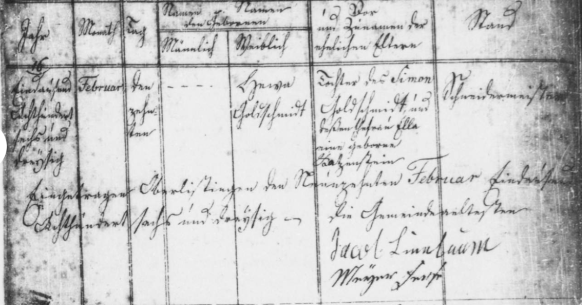










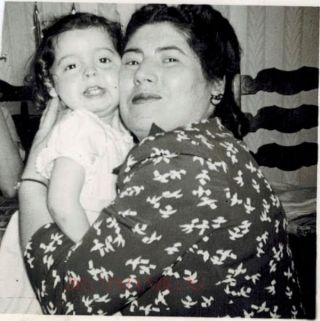








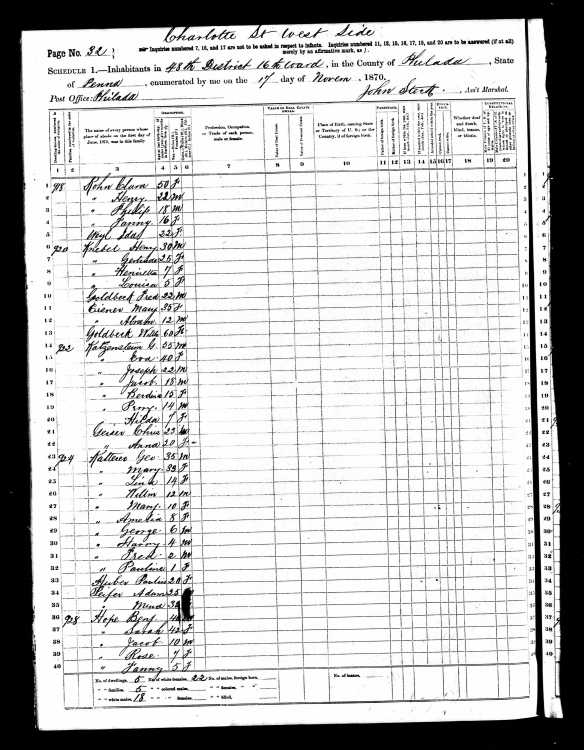






![Moynelle Katzenstein and Bert Spanye marriage record Ancestry.com. Pennsylvania, Marriages, 1852-1968 [database on-line]. Lehi, UT, USA: Ancestry.com Operations, Inc., 2016. Original data: Marriage Records. Pennsylvania Marriages. FamilySearch, Salt Lake City, UT.](https://brotmanblog.files.wordpress.com/2017/01/moynelle-katzenstein-bert-spanye-marriage-license.jpg?w=584&h=458)





![Katzensteins in 1909 Cleveland directory Title : Cleveland, Ohio, City Directory, 1909 Source Information Ancestry.com. U.S. City Directories, 1822-1995 [database on-line]. Provo, UT, USA: Ancestry.com Operations, Inc., 2011.](https://brotmanblog.files.wordpress.com/2017/01/katzensteins-in-1909-cleveland-directory.jpg?w=584)
![Katzensteins in 1912 Cleveland directory Title : Cleveland, Ohio, City Directory, 1912 Source Information Ancestry.com. U.S. City Directories, 1822-1995 [database on-line]. Provo, UT, USA: Ancestry.com Operations, Inc., 2011. Original data: Original sources vary according to directory.](https://brotmanblog.files.wordpress.com/2017/01/katzensteins-in-1912-cleveland-directory.jpg?w=584)
![Massachusetts Institute of Technology Class of 1913 Ancestry.com. U.S., School Yearbooks, 1880-2012 [database on-line]. Provo, UT, USA: Ancestry.com Operations, Inc., 2010. Original data: Various school yearbooks from across the United States.](https://brotmanblog.files.wordpress.com/2017/01/vernon-katzenstein-mit-class-or-2013.jpg?w=584&h=798)

![Milton Boyd Katzenstein, 1904 yearbook for the UPenn Medical School Ancestry.com. U.S., School Yearbooks, 1880-2012 [database on-line]. Provo, UT, USA: Ancestry.com Operations, Inc., 2010. Original data: Various school yearbooks from across the United States.](https://brotmanblog.files.wordpress.com/2017/01/milton-katzenstein-med-school-upenn.jpg?w=584&h=730)
![Milton Boyd Katzenstein military record Box Title : Kapp, Edward B - Kauffman, Frank (221) Source Information Ancestry.com. Pennsylvania, WWI Veterans Service and Compensation Files, 1917-1919, 1934-1948 [database on-line]. Provo, UT, USA: Ancestry.com Operations, Inc., 2015. Original data: World War I Veterans Service and Compensation File, 1934–1948. RG 19, Series 19.91. Pennsylvania Historical and Museum Commission, Harrisburg Pennsylvania.](https://brotmanblog.files.wordpress.com/2017/01/milton-katzenstein-military-record.jpg?w=584&h=747)
![Box Title : Kapp, Edward B - Kauffman, Frank (221) Source Information Ancestry.com. Pennsylvania, WWI Veterans Service and Compensation Files, 1917-1919, 1934-1948 [database on-line]. Provo, UT, USA: Ancestry.com Operations, Inc., 2015. Original data: World War I Veterans Service and Compensation File, 1934–1948. RG 19, Series 19.91. Pennsylvania Historical and Museum Commission, Harrisburg Pennsylvania.](https://brotmanblog.files.wordpress.com/2017/01/milton-katzenstein-military-record-2.jpg?w=584&h=419)
![Title : The Official Roster of Ohio Soldiers, Sailors, and Marines in the World War Volume 9 Source Information Ancestry.com. U.S., Adjutant General Military Records, 1631-1976 [database on-line]. Provo, UT, USA: Ancestry.com Operations, Inc., 2011.](https://brotmanblog.files.wordpress.com/2017/01/ivan-katzenstein-ww1-record-from-ohio-soldiers.jpg?w=584&h=118)

![Title : The Official Roster of Ohio Soldiers, Sailors, and Marines in the World War Volume 9 Source Information Ancestry.com. U.S., Adjutant General Military Records, 1631-1976 [database on-line]. Provo, UT, USA: Ancestry.com Operations, Inc., 2011.](https://brotmanblog.files.wordpress.com/2017/01/vernon-katzenstein-military-record-ww1-ohio-roster.jpg?w=584&h=97)



![Howard, Ivan, and Vernon Kay 1921 Cleveland directory Title : Cleveland, Ohio, City Directory, 1921 Source Information Ancestry.com. U.S. City Directories, 1822-1995 [database on-line]. Provo, UT, USA: Ancestry.com Operations, Inc., 2011. Original data: Original sources vary according to directory.](https://brotmanblog.files.wordpress.com/2017/01/kay-brothers-1921-cleveland-directory.jpg?w=584&h=328)
![1922 Catalog of the University of Pennsylvania Ancestry.com. U.S., College Student Lists, 1763-1924 [database on-line]. Provo, UT, USA: Ancestry.com Operations, Inc., 2012. Original data: College Student Lists. Worcester, Massachusetts: American Antiquarian Society.](https://brotmanblog.files.wordpress.com/2017/01/milton-katzenstein-upenn-alumni-mag-1922.jpg?w=584&h=178)













